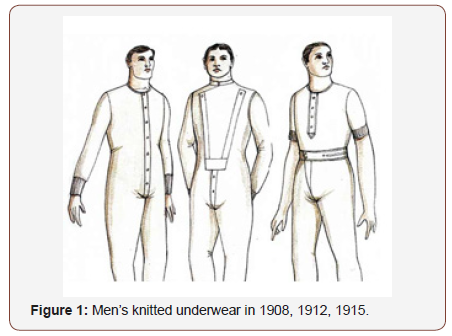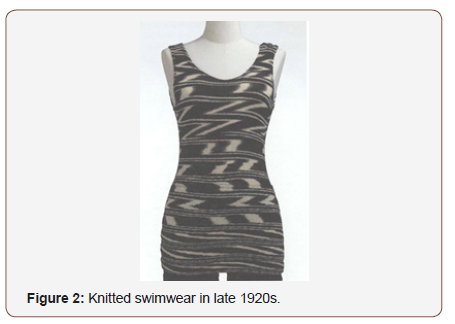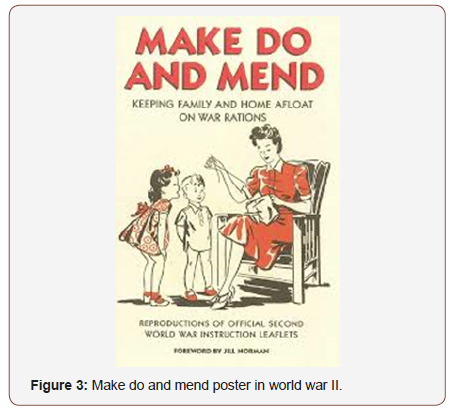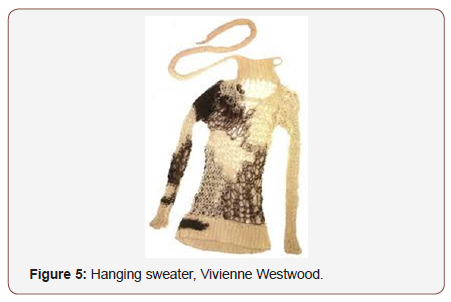 Research Article
Research Article
The Social Interpretation of Knitwear
Li Zeng1, Zhimin Chen2* and Osmud Rahman3
1School of Art and Design, Shenzhen Polytechnic University, China
2Manchester Fashion Institute, Manchester Metropolitan University, Manchester, UK
3School of Fashion, Ryerson University, Toronto, Canada
Zhimin Chen, Manchester Fashion Institute, Manchester Metropolitan University, Manchester, UK.
Received Date: July 08, 2019; Published Date: July 16, 2019
Abstract
The advancement of technology has been changing the course of human history and also the way we live. For example, the development of knitting technology had changed and shaped people’s social values and world view alongside with many socio-economic and political changes. In order to understand the significance and social impact of knitwear, this paper focuses on how social meaning was created through knitting and knitted artefacts from various perspectives, including the societal status of knitwear, the relationship between knitwear and gender, the impact of physical health and sports on knitting, and the pan-politicization of knitting.
During the first half of twentieth century, knitwear was primarily made at home, and these handmade knitted products conferred on the wearer were often perceived as low-end commodities. However, due to modernization, technological advancement and the disruption of war, the democratization of knitwear was fostered and cultivated, and the knitting industry was shifted from male-dominated industry to female-dominated. Whilst the knitting hobby embodied women’s traditional values and position in a family, the emergence of women’s knitwear during the wars reflected the richness of their social engagement. Following World War II, knitwear has become a socio-political weapon to express social ideologies through the manifestation and emancipation of Women’s Liberation Movement. In addition to feminist movement, health consciousness played a significant part on creating intimated clothing or underwear, leisure activities such as swimming had led to the change of women’s bathing suit, and the popularity of sports drove consumers’ demand for casual attire and functional knitwear.
Keywords: Knitting; Knitwear; Society; Politics; Women’s Liberation
Introduction
The most ancient knitted fabric can be traced back to 256 BC in the Arabian regions. Early knitted fabrics were used for protection and warmth. Since the invention of knitting, most people believe that knitting are often associated with family and women – older women in particular. Knitting activities often perceived as women’s love and devotion towards her family by knitting different items for her family members such as baby socks, gloves, scarves and other inexpensive clothing. However, from in-depth exploration of social significance, this type of perception could be bias and subjective. Once the knitting goes beyond the initial stages of the process and simple basic forms, the complexity of knitwear and technology is extended at all levels of social meaning. Accompanied with a series of historical conflicts, changes and subversion, knitting ups and downs, which not only reflects the development of technology, but also carries the social, historical and cultural significance.
Social Status of Knitting
The first step of conducting a social study of knitting is to clarify the status of knitting and knitted products. The social status of knitting was decided by the superstructure. Before the industrial revolution, knitting has existed as a family craft and handicraft industry. The industrial revolution has changed the social status of the knitting industry and knitwear. The arts and crafts movement had revived hand knitting. However, in the middle and late 19th century, knitting has lost its position in fashion. The first half of the 20th century, the prevalence of knitting reflected the process of democratization.
Knitting status reflects the changes of history and social stratum
Positive modernization process embodied the mechanization in the knitting industry. In 1589 William Lee invented knitting machine, knitting began mechanization. Machine knitting was still considered as a handicraft industry, because production organization system of knitting at that time was the manufacturer’s outsourcing of the garment to the family for knitting. Then the great industrial revolution led to a sharp increase in textile production, product types were rich and varied, which was a serious blow to the traditional textile industry, including knitting industry, knitting transformed from hand-workshop production into factory production.
Mechanization caused the collapse of a large number of organized handicraft industry, resulting in scarcity of handmade products, but the position of manual products jumped. Textile professionals argue that centuries ago, luxury handmade textiles were of high quality, obtained a high-end status in the form of high value of labor-time; mass-produced machine knitting were inevitably inferior in quality, so they were low-grade, the upper class strongly opposed machine products. Actually, this feeling of inferior quality of machine knitting is not a product quality problem. Machine knitting for the nascent middle class rather than the upper class, in fact, reflected the upper class’s concerns and fear for the growing middle class and the middle class’s replication of the upper-class social life.
The family orientation and low-end of knitting status
In the mid-19th century, the invention of sewing machines brought mechanization into the family, in the late 19th century home knitting machine made hand knitting more obsolete, these two social phenomena further reduced the status of knitting. Any item could be made at home, its position in the commodity economy could not be guaranteed. In the fashion area, non-practicality of frivolous luxury embroidery and lace made the practical knitting more low-end. Raw materials that could be used both for household production, but also for scale production were low-level, this feature of raw materials of knitting increased the disadvantage of knitting. Thus, knitting had lost its status both in society and in fashion.
Democratization of knitting status
The time of knitwear entering mainstream of fashion dated back to 1920s. At that time Chanel designed a three-piece knitting garment: cardigan, skirts and pullovers, which did not need servants to help wear, easy to produce and reproduce, became women’s essential clothing. This popularity of casual wear arose from the aristocratic, down to citizen, brought democracy into the field of fashion, and this civilian-oriented and leisure aesthetic concerted with modern trend of healthy and active image. During World War II there was also a democratization of knitting garments, the public and the army wore the same clothes. Modernization and war promoted the process of democratization of knitted garments, the spread and prevalence of knitwear in the society, reflects the collapse of hierarchical concept based on class and elite.
Knitting and Gender Culture
When it comes to knitting, people tend to associate it with women, especially older women. Knitters were treated as a single gender group - feminine, knit and feminine, even have interchangeable textual meanings. Women had regarded as housewife and male vassals for a very long period of time, until the early twentieth century when the new female wind was blowing, the 1960s when female liberation movement rose, and contemporary era when feminism is current, the female role has been gradually changing. And knitting plays an important role in identifying and constructing the female identity in the dual-gender system, which confirms the promotion of women’s social status under the patriarchal system.
The evolution of gender roles in knitting
Both men and women have been involved in hand knitting to earn income or exchange for necessities. Man, invented knitting machines, before 1657 knitting guild only accepted male members, knitting industry was controlled by male, all this means that machine knitting associated with men, women was regarded as hand-knitters. In 19th century arts and crafts movement were not only about the status of handicrafts, but also about gender status. Traditional craftsmen are men, members of the Maurice movement dominated by men, women’s design and skills were often not recognized, women descended to an overlooked and negative Muse role. But skilled women undertook clothing knitting, opened clothing stores mainly selling wool and headwear. Obtaining the economic benefits and value through knitting, women increased their income, and even made a successful career. Therefore, the male-dominated knitting industry had nurtured the success of women, made knitting as a synonym for women, promoted the status of women in modern capitalist society recognized and even respected, the dissolution of male’s gender superiority in the industrial society.
Knitting and women’s hobbies
The nineteenth-century professional hand-knitters knitted expensive high-grade knitwear, and soon family knitting was marginalized and relegated from handicrafts to hobbies. Hobbies, this recreational culture originated from family division of labor in the 19th century, when the middle-class men went out to work, and women, known as the “angels in the house” were at home, parenting, making home decorations and upper-class handicrafts. Knitting skills were the hallmarks of decent women, which were admirable but did not create economic value and had no place in the economic world. This can be interpreted as knitting becoming a female party or housework. With the continuous development of knitting as a hobby for women, knitting was more closely related to humble women’s cultural and economic status, which deepened the stereotype of knitting in gender and class. Knitting hobby became a manifestation of women’s passive social status.
“New women” era and the mainstream of knitted garments
In the early 20th century, knitted garments entered into the mainstream of fashion, knitted fashion and modern women finally linked together. Between the two world wars was the important period of female social, political and economic liberation, this was the “new women” era. Women had a more freedom, more active lifestyle than before, and needed clothing suitable for a new era. Chanel’s knitted three-piece design can be worn from early to late, became a new women’s professional fashion. The versatility of the knitwear in terms of time and space reflected the colorful life of young women at that time. Knit got rid of the old-fashioned image, occupied the fashion world with a wealth of creative. The characteristics of knitted fabrics not only made clothing modeling, but also the body not restricted, which implied that women liberation from the shackles of the hierarchical system. High fashion smiling to and embracing knitwear was not just a direct result of the war, but also the results of removing male dictatorship. The prewar popular knitted swimsuit was also a material presentation of female and their body’s socialization, revealing the body’s sexual attraction was a milestone breakthrough for the status of women. But in 1930, J. C. Flugel, a fashion psychologist, argued that fashion changes were largely due to sexual competition, and that the attraction of the knitted swimsuit, in addition to the pleasure of women herself, still largely depended on men’s approval.
Postwar gender equality and rebel knitted garments
In the 1960s and 1970s, women’s political rise, in the streets of Europe women actively fought for the rights and body, the younger generation and sub-cultural groups challenged the traditional gender roles. In 1968 Knitwear designer Sonia Rykiel subverted women’s traditional image of the high fashion Salon, created fashion female image discussing politics in Paris café [1]. Designer’s interpretation of this struggle for freedom and equality: wearing a sweater without bra inside, the body’s comfort was equivalent to gender comfort. Knitwear once again became the symbolic language of freedom of the second sexual.
Knitting and Health
Underwear and sportswear as two important categories of knitted garments, closely related with health, hygiene and sports, the prevalence of knitwear was caused by the social upsurge, which was awakened by this awareness. At the same time, the evolution of knitwear materials and styles also reflected changes in people’s demand for health, hygiene and movement.
The prevalence of knitted underwear and awakening awareness of health and hygiene
In 1890’s, debate of health and hygiene was very hot, knitting status in the medical profession area had been unexpectedly improved. German biologist and scientist Dr. Gustav Jaeger published “Standardized Apparel for Health Protection”, which advocated wearing knitted woolen underwear for health and hygiene, suggested that wearing undyed wool fibers in the body could extract toxins, allowing the body to breathe freely [2]. Under his name, the British company Jaeger specialized in the production of underwear and unisex knitted garments. These Jaeger clothing quickly smelled the streets, although not fashionable, but made a contribution to the reform of way of life. Figure 1 were classic men’s knitted underwear in 1908, 1912, 1915 [3]. In the rational-led Western society, scientific recognition of knitting greatly improved the status.

Changes of knitted swimsuits and the development of swimming
In the early twentieth century, swimming movement prompted knitting fashionable. Australian swimming star Annette Kellerman, who visited United States in 1907, recommended a simple onepiece wool swimsuit. The 1912 Olympic Game allowed women to swim and swim began to prevail. Knitting swimsuit became popular quickly. In 1926 Gertrude Ederle swim across the English Channel, broke the two-hour record which maintained by men, and further led to the popularity of second swimming and swimwear in the coming second half of the 1920s. Wool and silk one-piece knitted swimsuit, Tank suit, imitated the early men’s swimwear, sleeveless, rectangle feet, rich colors and patterns; semi-elastic swimsuit fitted female’s body, replacing culottes and skirts in Edward era of the 1920s, more suitable for water sports [4]. As the ad of swimwear company Jantzen “The suit that changed bathing into swimming [5]”, from travel posters of seaside vacation to Hollywood movies with swimsuit beauty, knitted swimsuit is ubiquitous. In fact, swimming is not the essence of reform of knitted swimwear, every woman wanted to swim just to have a knitted swimsuit, to achieve the ideal female image of this era, to achieve self-fantasy. Swimming sports became a catalyst for modernization and practical of women’s knitted swimsuit. Figure 2 is a wool knitted swimwear with abstract pattern in the late 1920s [6].

The promotion of sports awareness promoted the development of knitted garments
During the two world wars and in the 1980s, is two major periods of sports awareness raising, knitting sportswear rapidly developed. During the post-war peacetime, the rich were busy with various sports such as polo, sailing, horse racing and tennis. In 1926 the British Vogue wrote that “ the perfection of adaption to the needs of a game which modern dress has evolved [7]”. For example, in 1920 Lewis Lacey designed polo shirt, embroidery trademark of polo originated from Hurlington Polo Club near Buenos Aires; Rene Lacoste who was champion of France Grand Slam Tennis for seven times, designed white short-sleeved cotton knitwear, back panel was longer than the front, now known as the “tennis tail”, and in 1926 US Open Championship the designer first wore it [8]; in 1980s sports commercialized, Nike, Adidas and Reebook and other international sportswear brand began to tap the fitness market, sportswear globalized and became daily, but knitted sportswear was still not considered to belong to fashion. The enhancing awareness of health and sports brought the development of knitted garments, which implied a change of social lifestyle, knitting supports the enhancement of the quality and extension of individual life from the clothing level.
Knitting and Politics
It is often difficult to relate knitting to politics, but an in-depth history reveals that knitting and politics are inseparable. Knitting has become the carrier of people’s expression of political intention. Whether knitting itself, knitwear or knitwear advertisements, all of them infiltrate the ideological tendency of the government or the individual. Political organizations use knitting to express political demands through community activities. On social objects such as war, race, groups and classes, knitting has made presentation and interpretation of the temperament of the times.
Patriotism of knitting in World War II
All the countries affected by the second world wars implemented deflation policy, in 1941 British carried out rationing system, in 1943 the United States enacted the L85 [9], regulated garment production, advocated “Make do and mend” campaign, See Figure 3 [10], Adverb of British yarns merchandiser Sirdar Wools was “If you can knit, you can do your bit” [11]. Women used old clothes and old materials, unraveled old wool knitwear, straightened the yarn with steaming, re-knitting; mended heels of socks and stockings to sock. The policy of Patriotism Knitting encouraged men, women and children to knit gloves, socks, masks and sweaters for the army, with patriotic-motif patterns such as “V” for victory. Knitting in this period represented saving and glory; the renaissance of handknitting became the social responsibility of the individual; family knitting renewed as a thrifty way and associated with patriotic rather than fashion; knitting became a political tool, had functions of practicability and collective spirit.

The Politicization of knitwear postwar
The most shocking and subversive knitwear event in history was the advertising of the Italian knitwear brand Benetton in the 1980s and 1990s. Knitwear triggered a huge controversy unprecedented, caused a sensation in the world, led to public anger, which may be the first time since 1812 Leder movement & [12,13], in the Parliament, to discuss knitwear. Knitwear as the main commodity of Benetton, its advertisements rarely point to the clothing itself, but to show the ethnic politics, AIDS, child labor, capital punishment and violent conflicts and other social problems, forcing people to look directly into their own discrimination bias when facing the controversial public topic. Some countries even prohibited one or more ads. In 2000 Benetton advertisements focused on the death penalty, filmed in several American prisons, led to a strong concern of mainstream community, see Figure 4 [14]. In 2003 the artist Cat Mazza began “Nike Blanket Petition” project, 4-inch knitted pieces donated by individuals from the United States and other 20 countries, composed of blanket, featuring the Nike logo, as a support for the Nike workers’ petition, meaning labor issue of sweatshop factory. This kind of knitting activity or microrevolution shows that the knitting garment goes too far away from the function and aesthetics of the knitting itself, but as a weapon points to politics, and has a heavy effect in bearing political issues.

Knitwear subverted mainstream politics
In the sixties and seventies of last century, knitted garments showed a dual system, in the upper society, knitted pullovers and knitted two-piece were stylized clothing of middle-class; on the opposite side, another type of knitted garments means subversion of mainstream politics, challenging the middle class who wore traditional garments. Bohemian-style knitwear was popular in the mainstream society in 1970s, romantic and escaping the reality; young people and sub-cultural groups, because of economic crisis and left-wing politics, arose punk movement. This anti-mainstream movement deconstructed the traditional clothing, T-shirt was tearing, made hole, printed subversive patterns and slogans, punk sweater had strong glaring colors, deliberately designed holes. In 1977, instigators of this anarchist movement, Vivienne Westwood, designed hanging sweater to subvert the traditional comfort concept of knitting, the rib collar extended for the hanging lasso, the sleeve length could wind the body like tights, irregular placement of irregular loops created a chaotic surface, irregular black and white blocks of clothing further added a sense of chaos, see Figure 5 [15]. The combination of punk and knitwear once again presented political significance, deliberately created ugly knitwear to expose the dark side of the finest things, confronted and subverted decent bourgeois society, and showed how to break the political balance.

Conclusion
Knitting is not just clothing and entity of handicraft, as well as the carrier of consciousness and spirit, embodies the social and historical trends. No matter it is the ups and downs of knitting social status, or the development of knitted garments in gender, sports health and hygiene movement, or the political significance of knitting in world war and postwar, interpretation of knitting in each social category, provided more themes and inspiration for knitwear design, also put forward new meanings and requirements on the development of knitting and knitted garments. The social study of knitting can be further deepened in the perspectives of ideology, education, geography, literature etc., to explore the deeper connotation behind knitting [16,17].
Acknowledgement
None.
Conflict of Interest
No conflict of interest.
References
- Boucher F (1987) 20000 Years of Fashion. Harry N. Abrams, Inc, New York, USA.
- Donofrio-Ferrezza L, Marilyn H (2008) Designing a knitwear collection: from inspiration to finished garments. Fairchild Books, New York, USA.
- http://www.german-hosiery-museum.de
- www.thenewwaveknitter.blogspot.com.
- Dirix E (2011) Unravel: Knitwear in Fashion. Editions Lannoo sa, p. 192.
- Lynch A, Strauss M (2007) Changing Fashion. (1st edn), Oxford: Berg, USA, p.224.
- Fogg M (2010) Vintage Fashion: Knitwear: Collecting and Wearing Designer Classics (Vintage Fashion Series). Lark Crafts, New York, USA, p.224.
- http://en.wikipedia.org/wiki/1930–45_in_fashion.
- www.khadijashumibegum.blogspot.com.
- www.advertolog.com.
- Fogg M (2010) Vintage Fashion Knitwear. Lark Books, New York, USA, p.33.
- Bressler KW, Newman K, Proctor G (1998) A Century of Style Lingerie. Quarto Publishing, USA.
- (1942) The US Wartime Production Council issued a regulation L85 to restrict each category of women’s wear.
- www.khadijashumibegum.blogspot.com
- Led Movement: a social movement. The 19th century British Industrial Revolution forced a large number of skilled workers to be laid off, they organized protests against the industrial revolution, against the textile industry.
- www.advertolog.com.
- www.thenewwaveknitter.blogspot.com.
-
Li Zeng, Zhimin Chen, Osmud Rahman. The Social Interpretation of Knitwear. J Textile Sci & Fashion Tech. 3(2): 2019. JTSFT. MS.ID.000560.
-
Knitting, Knitwear, Society, Politics, Women’s liberation
-

This work is licensed under a Creative Commons Attribution-NonCommercial 4.0 International License.






